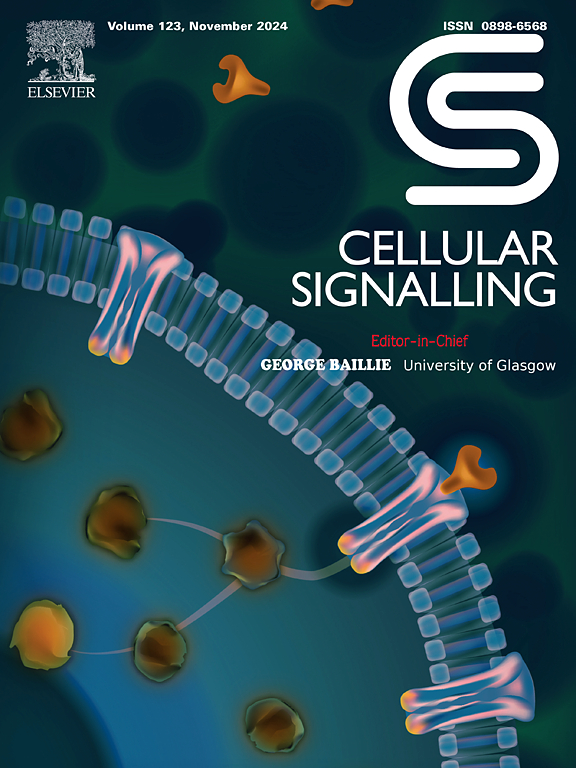Wnt5a通过调节颗粒细胞中PI3K/AKT/mTOR通路介导的自噬来缓解PCOS的症状。
IF 4.4
2区 生物学
Q2 CELL BIOLOGY
引用次数: 0
摘要
目的:多囊卵巢综合征(PCOS)是一种代谢和内分泌疾病,包括排卵失调、雄激素过多和多囊卵巢。虽然Wnt5a被认为在正常情况下对卵泡发育和女性生育能力起关键作用,但其在PCOS中的功能尚未确定。因此,本研究旨在探讨Wnt5a对PCOS患者卵巢颗粒细胞自噬的影响,并提供体外证据支持其在此情况下的作用。方法:以dht诱导的颗粒细胞(KGN)为体外模型,采用Western blotting检测细胞中Wnt5a及自噬相关蛋白水平。我们还通过干扰和抑制剂下调KGN细胞中Wnt5a的表达,并使用Western blotting、RT-PCR和免疫荧光策略检测自噬相关因子和PI3K/AKT/mTOR通路相关因子。在体内,BOX5在dhea诱导的PCOS小鼠模型中作为Wnt5a的治疗抑制剂进行了测试。采用苏木精染色检测卵巢形态学变化,ELISA检测E2、T激素水平,Western blotting、免疫荧光、免疫组织化学检测自噬相关因子。结果:dht诱导的KGN细胞中Wnt5a及自噬相关蛋白水平显著升高。在这些细胞中下调Wnt5a后,与DHT组相比,自噬相关因子水平显著降低,通路相关因子水平显著升高。在小鼠中,BOX5处理足以恢复血清雄激素水平,改善多囊卵巢的变化,同时也抑制卵巢颗粒细胞内自噬相关因子的水平。结论:Wnt5a下调可通过激活PI3K/AKT/mTOR通路抑制PCOS颗粒细胞的自噬,并可修复多囊卵巢病变,使血清性激素水平正常化。本文章由计算机程序翻译,如有差异,请以英文原文为准。
Wnt5a alleviates the symptoms of PCOS by modulating PI3K/AKT/mTOR pathway-mediated autophagy in granulosa cells
Objective
Polycystic ovary syndrome (PCOS) is a metabolic and endocrine disease that entails dysregulated ovulation, hyperandrogenism, and polycystic ovaries. While Wnt5a has been suggested to play key roles in follicular development and female fertility under normal conditions, its functions in the context of PCOS have yet to be established. This study was thus designed to explore the impact of Wnt5a on ovarian granulosa cell autophagy in PCOS, providing in vitro evidence in support of its role in this setting.
Methods
DHT-induced granulosa (KGN) cells were used as an in vitro model, and Wnt5a and autophagy-related protein levels in these cells were detected via Western blotting. Downregulating the expression of Wnt5a in KGN cells (by interference and inhibitor) was also performed, and Western blotting, RT-PCR, and immunofluorescence strategies were used to detect autophagy-related and PI3K/AKT/mTOR pathway-associated factors in this setting. In vivo, BOX5 was tested as a therapeutic inhibitor of Wnt5a in a murine model of DHEA-induced PCOS. Changes in ovarian morphology were detected through hematoxylin staining, while E2 and T hormone levels were quantified by ELISA, and autophagy-related factors in these animals were quantified through Western blotting, immunofluorescence, and immunohistochemistry.
Results
Wnt5a and autophagy-related protein levels rose significantly in DHT-induced KGN cells. Following downregulation of the Wnt5a in these cells, a significant decrease in autophagy-related factor levels was noted relative to the DHT group, together with significant increases in pathway-related factors. In mice, BOX5 treatment was sufficient to restore serum levels of androgen and to improve polycystic ovarian changes, while also suppressing the levels of autophagy-associated factors within ovarian granulosa cells.
Conclusion
Wnt5a downregulation suppresses autophagy in PCOS granulosa cells through the activation of the PI3K/AKT/mTOR pathway, in addition to remediating polycystic ovarian changes and normalizing serum levels of sex hormones.
求助全文
通过发布文献求助,成功后即可免费获取论文全文。
去求助
来源期刊

Cellular signalling
生物-细胞生物学
CiteScore
8.40
自引率
0.00%
发文量
250
审稿时长
27 days
期刊介绍:
Cellular Signalling publishes original research describing fundamental and clinical findings on the mechanisms, actions and structural components of cellular signalling systems in vitro and in vivo.
Cellular Signalling aims at full length research papers defining signalling systems ranging from microorganisms to cells, tissues and higher organisms.
 求助内容:
求助内容: 应助结果提醒方式:
应助结果提醒方式:


